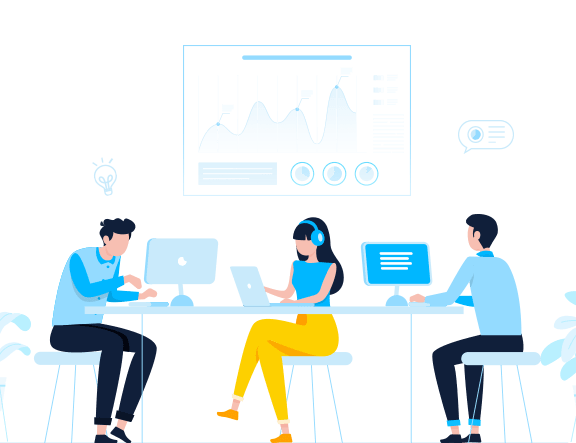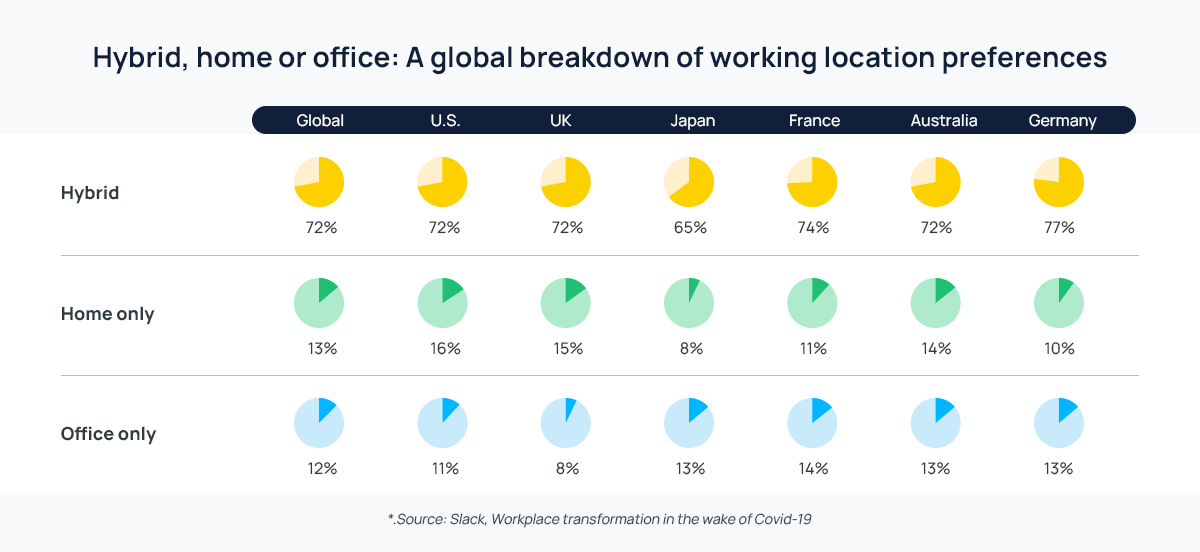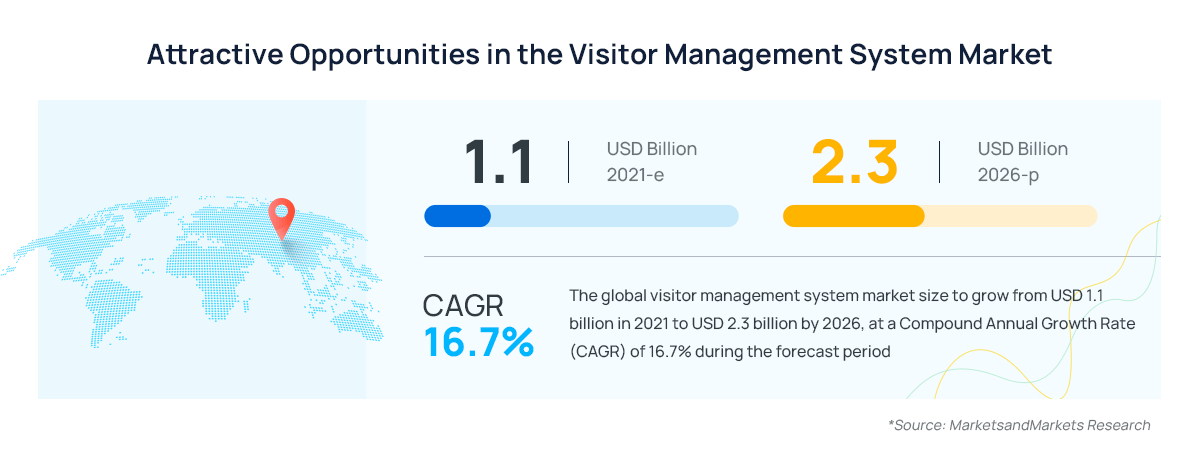 We’ve been living through the greatest workplace disruption in generations and the level of volatility will not slow down in 2022. In the past two years, just as e-commerce changed the way people think about brick-and-mortar storefronts, so is the forced mass adoption of remote work changing the way people think about the workplace.
We’ve been living through the greatest workplace disruption in generations and the level of volatility will not slow down in 2022. In the past two years, just as e-commerce changed the way people think about brick-and-mortar storefronts, so is the forced mass adoption of remote work changing the way people think about the workplace.
In one of recent global survey of more than 16,000 employees across multiple industries, more than half (54%) of workers revealed considering leaving their job post-pandemic if they are not offered some form of flexibility in where and when they work. And hybrid working model is now taking center stage.

Along with the shift, centralized office evolution also become the focus of many organizations. Employers are considering new ways to manage a hybrid workforce and retain a certain level of productivity without sacrificing the workplace culture. As a result, there are some clear digital workplace trends emerging to accommodate the new normal.
So what are these workplace trends and what technologies should companies be factoring into their modern digital workplaces moving forward?
Read on to explore the new workplace realities and digital transformation technologies applied.
1. Boom in Activity Based Working & Hybrid Meetings
From a company culture standpoint, the opportunity for colleagues to work together in close proximity is valuable. It’s no wonder why “Hybrid Meetings” and “Activity-based Working” (ABW, which implies a strategy that people go to office for projects and collaborative spaces) became the most widely-adopted strategies when companies start planning a return to office. Yet managing dispersed workforce with scheduling gaps is not that easy. You need to have the right technology to support both in-person team collaboration and meetings, as well as mixed on-site and remote attendance.
That’s where digital solutions like meeting room scheduling systems can make a big difference. They provide essential tools for employees to explore office meeting room availability from anywhere (with all important info like meeting room capacity, equipment, real-time occupancy & schedules, etc.) and reserve collaborative spaces easily whenever they need them. Should any hybrid or in-office collaboration be required, just tap from a web or even daily calendars like Google & Microsoft Outlook, your office room reservation and meeting invites are on the go simultaneously.
The basis of fully flexible work is to create a shared platform that bridges the gaps and keeps the collaboration process smooth and simple. And with unified meeting reservation, notifications, and physical space scheduling in one place, a Meeting Room Scheduling System could fit into the niche just right.
2. Increased Adoption of Shared Desking, Offices, and Spaces
The number of employees “in the office” continues to be dynamic for many organizations. Driven not only by pandemic response, but increasingly by employee choices of when and where to work, the workplace today is poised to manage fewer people and less spaces. And as much as business leaders want to avoid the expense of empty real estate, the demand for hot-desking will increase dramatically in the next few years, with a predicted 200% growth of coworking spaces from 2021 to 2024.
“UnWork, the future work specialists, predicts a reduction of £10,000 per person per year in workplace costs by providing far fewer, shared desks.”
To manage office desk resources efficiently, “Hot Desking” in the post-pandemic offices require dedicated desk booking tools and will be more “touch-free”. Besides the basic functions of desk search & reservation, touchless technologies like QR code and RFID/NFC tag for desk check-in/check-out will be in demand. And collaboration features like find-a-colleague (allows users to locate coworkers in vicinity by seeing which spaces have been booked and by whom) will also be integral to create modern offices.
3. Importance Attached to Employee Health & Workplace Safety
With organizations continue to adopt a hybrid office model, in-office security and employee health also fall into the spotlight. A global report conducted by Entrust in June 2021 has revealed that 93% of business leaders are paying more attention to office visitor tracking due to heightened sensitivity toward safety caused by the pandemic. And better workplace transparency is required to maintain health & safety standards with a dynamic workforce on a flexible schedule.
Given the new workplace atmosphere, visitor management system that incorporates visitor pre-registrations, front-desk check-in, and contact tracing abilities are increasingly implemented to mitigate the risks in the new hybrid context, and to help employers know who is coming to the office on a given day, and know where they’re working and who they’re working with.

4. More Data-driven Gap Analysis to Navigate through the New Landscape
What is standing between your present office and your hybrid workplace to evolve? Although hybrid working now formulated more rapidly than ever, there is still a lot of uncertainty around the post-pandemic office utilization. Data, therefore, will be the key to helping companies uncover new patterns, optimize employee experience, and adjust in-office operating costs.
Workspace analytics technology is here to fill the gap. Typically integrated with workplace scheduling solutions like Meeting Room/Desk/Visitor management systems mentioned above, workplace analytics provide insights into in-office worker density and space unitization. By tracking and analyzing office occupancy data, employers can see which spaces are underutilized or in high demand and adjust to match the demand. Moreover, some solutions also let you gather more granular data about how your employees are working. For example, the total time team spends on meetings, hybrid workforce in-office check-in patterns, etc.
Talk to Experts
As the hybrid working model takes the center stage, the question on workplace scheduling is no more about whether to support remote working or not, but about how to retain a no-less-than level of productivity under the new hybrid work context. That’s why more companies are investing in digital workplace technologies that are designed with efficiency and employee experience in mind.
While navigating through the extensive workplace solutions on the market, it’s essential to know what the future holds. We recommend that customers reach out to the experts. Talk to your trusted solution provider, or talk to us at Yeastar, who experts in Digital Workplace Scheduling Solution & Meeting Room Booking System, and take advantage of the knowledge already available. We’re all there to help you start developing your future workplace.


It’s great that you are getting thoughts from this article
as well as from our argument made at this place.